Three-Dimensional Trajectory Optimization for UAV-Based Post-Disaster Data Collection
Abstract
1. Introduction
2. Related Works
3. System Architecture
- 1.
- 2.
- The UAV departs from the starting point;
- 3.
- The UAV flies to the next hovering point;
- 4.
- The UAV collects data from all covered UEs;
- 5.
- Repeat 3~4 until all UEs’ data is collected;
- 6.
- The UAV returns to the starting point;
- 7.
- Send the collected data to the disaster response headquarters.
4. Numerical Analysis Methods
4.1. K-Means Clustering for Placement of Hovering Points
- For realistic problems, the number of clusters k is often difficult to determine in advance.
- Conditions such as the limitation of the UAV’s flight altitude, which is 150 m according to the law in Japan, are hard to include. As shown in Figure 7, the flight altitude is too high when k is small.
4.2. Genetic Algorithm for Placement of Hovering Points
- Selection
- Crossover
- Mutation
4.3. Nearest Neighbor Search for Trajectory Decision
5. Simulation Results
5.1. Placement of Hovering Points
5.2. Trajectory Optimization
6. Conclusions
Author Contributions
Funding
Institutional Review Board Statement
Informed Consent Statement
Data Availability Statement
Conflicts of Interest
References
- Ministry of Internal Affairs and Communications. Communication Situation in the Great East Japan Earthquake (in Japanese). Available online: https://www.soumu.go.jp/johotsusintokei/whitepaper/ja/h23/pdf/n0010000.pdf (accessed on 25 February 2025).
- National Institute of Information and Communications Technology. Disaster-Resilient Communication Networks: Introduction Guidelines (in Japanese). Available online: https://www.nict.go.jp/resil/pdf/guideline202006.pdf (accessed on 25 February 2025).
- Yamamoto Town. Damage from the Great East Japan Earthquake and Tsunami (in Japanese). Available online: https://www.town.yamamoto.miyagi.jp/site/fukkou/324.html (accessed on 25 February 2025).
- Ministry of Internal Affairs and Communications, Information and Communications in Japan White Paper 2022. Available online: https://www.soumu.go.jp/johotsusintokei/whitepaper/eng/WP2022/chapter-2_1.pdf (accessed on 23 May 2025).
- Sharma, A.; Vanjani, P.; Paliwal, N.; Basnayaka, C.M.W.; Jayakody, D.N.K.; Wang, H.C.; Muthuchidambaranathan, P. Communication and networking technologies for UAVs: A survey. J. Netw. Comput. Appl. 2020, 168, 102739. [Google Scholar] [CrossRef]
- Han, S.I. Survey on UAV Deployment and Trajectory in Wireless Communication Networks: Applications and Challenges. Information 2022, 13, 389. [Google Scholar] [CrossRef]
- Hussain, A.; Li, S.; Hussain, T.; Lin, X.; Ali, F.; AlZubi, A.A. Computing Challenges of UAV Networks: A Comprehensive Survey. Comput. Mater. Contin. 2024, 81, 1999–2051. [Google Scholar] [CrossRef]
- Gu, X.; Zhang, G. A survey on UAV-assisted wireless communications: Recent advances and future trends. Comput. Commun. 2023, 208, 44–78. [Google Scholar] [CrossRef]
- Choi, S.-C.; Kim, S.-Y. An Independent UAV-Based Mobile Base Station. Sensors 2025, 25, 1349. [Google Scholar] [CrossRef]
- Tran, G.K. Temporary Communication Network Using Millimeter-Wave Drone Base Stations. In Proceedings of the 2024 IEEE VTS Asia Pacific Wireless Communications Symposium (APWCS), Singapore, 21–23 August 2024; pp. 1–5. [Google Scholar] [CrossRef]
- Ozpolat, M.; Al-Rubaye, S.; Williamson, A.; Tsourdos, A. Integration of Unmanned Aerial Vehicles and LTE: A Scenario-Dependent Analysis. In Proceedings of the 2022 International Conference on Connected Vehicle and Expo (ICCVE), Lakeland, FL, USA, 7–9 March 2022; pp. 1–6. [Google Scholar] [CrossRef]
- Sumitani, T.; Tran, G.K. Study on the Construction of mmWave Based IAB-UAV Networks. In Proceeding of AINTEC 2022, December 2022. (Presented on Dec. 20). Available online: https://interlab.ait.ac.th/aintec2022/ (accessed on 10 June 2025).
- Zhao, R.; Tran, G.K. Completion Time Minimization for UAV-Based Post-Disaster Data Collection. In Proceeding of SmartCom2024, November 2024. Available online: https://ken.ieice.org/ken/program/index.php?mode=program&tgs_regid=22056851da7480742c6cdc2a4d2ee8ba037f1bacaa08ad023793482ee0bd2f85&layout=&lang=eng (accessed on 10 June 2025).
- Amrallah, A.; Mohamed, E.M.; Tran, G.K.; Sakaguchi, K. UAV Trajectory Optimization in a Post-Disaster Area Using Dual Energy-Aware Bandits. Sensors 2023, 23, 1402. [Google Scholar] [CrossRef]
- Tran, G.K.; Kamei, T.; Tanaka, S. Route Optimization of Unmanned Aerial Vehicle Sensors for Localization of Wireless Emitters in Outdoor Environments. Network 2023, 3, 326–342. [Google Scholar] [CrossRef]
- Deruyck, M.; Wyckmans, J.; Joseph, W.; Martens, L. Designing UAV-aided emergency networks for large-scale disaster scenarios. J. Wirel. Commun. Netw. 2018, 1, 79. [Google Scholar] [CrossRef]
- Masaoka, R.; Tran, G.K.; Nakazato, J.; Sakaguchi, K. The Future of Flying Base Stations: Empirical and Numerical Investigations of mmWave-Enabled UAVs. Future Internet 2024, 16, 5. [Google Scholar] [CrossRef]
- El Debeiki, M.; Al-Rubaye, S.; Perrusquía, A.; Conrad, C.; Flores-Campos, J.A. An Advanced Path Planning and UAV Relay System: Enhancing Connectivity in Rural Environments. Future Internet 2024, 16, 89. [Google Scholar] [CrossRef]
- Wang, W.; Wei, X.; Jia, Y.; Chen, M. UAV relay network deployment through the area with barriers. Ad Hoc Netw. 2023, 149, 103222. [Google Scholar] [CrossRef]
- Chandran, I.; Vipin, K. Multi-UAV networks for disaster monitoring: Challenges and opportunities from a network perspective. Drone Syst. Appl. 2024, 12, 1–28. [Google Scholar]
- Zhang, Y.; Kuang, Z.; Feng, Y.; Hou, F. Task Offloading and Trajectory Optimization for Secure Communications in Dynamic User Multi-UAV MEC Systems. IEEE Trans. Mob. Comput. 2024, 23, 14427–14440. [Google Scholar] [CrossRef]
- Zhang, T.; Lei, J.; Liu, Y.; Feng, C.; Nallanathan, A. Trajectory Optimization for UAV Emergency Communication With Limited User Equipment Energy: A Safe-DQN Approach. IEEE Trans. Green Commun. Netw. 2021, 5, 1236–1247. [Google Scholar] [CrossRef]
- Li, M.; Liu, X.; Wang, H. Completion Time Minimization Considering GNs’ Energy for UAV-Assisted Data Collection. IEEE Wirel. Commun. Lett. 2023, 12, 2128–2132. [Google Scholar] [CrossRef]
- Li, J.; Zhao, H.; Wang, H.; Gu, F.; Wei, J.; Yin, H.; Ren, B. Joint Optimization on Trajectory, Altitude, Velocity, and Link Scheduling for Minimum Mission Time in UAV-Aided Data Collection. IEEE Internet Things J. 2020, 7, 1464–1475. [Google Scholar] [CrossRef]
- Al-Hourani, A.; Kandeepan, S.; Lardner, S. Optimal LAP Altitude for Maximum Coverage. IEEE Wirel. Commun. Lett. 2014, 3, 569–572. [Google Scholar] [CrossRef]
- Singh, A.; Redhu, S.; Hegde, R.M. UAV Altitude Optimization for Efficient Energy Harvesting in IoT Networks. In Proceedings of the 2022 National Conference on Communications (NCC), Mumbai, India, 24–27 May 2022; pp. 350–355. [Google Scholar]
- Dai, X.; Duo, B.; Yuan, X.; Renzo, M.D. Energy-Efficient UAV Communications in the Presence of Wind: 3D Modeling and Trajectory Design. IEEE Trans. Wirel. Commun. 2024, 23, 1840–1854. [Google Scholar] [CrossRef]
- Alzenad, M.; El-Keyi, A.; Yanikomeroglu, H. 3-D Placement of an Unmanned Aerial Vehicle Base Station for Maximum Coverage of Users With Different QoS Requirements. IEEE Wirel. Commun. Lett. 2018, 7, 38–41. [Google Scholar] [CrossRef]
- Basnayake, V.; Mabed, H.; Canalda, P.; Jayakody, D.N.K. Continuous and Responsive D2D Victim Localization for Post-Disaster Emergencies. IEEE Trans. Mob. Comput. 2024, 23, 7422–7437. [Google Scholar] [CrossRef]
- Yu, J.; Ye, F. User Equipment Localization and Victim Estimation with Next-Generation PSC in Emergency Response. In Proceedings of the 2019 IEEE Global Communications Conference (GLOBECOM), Waikoloa, HI, USA, 9–13 December 2019; pp. 1–6. [Google Scholar]
- Yabe, T.; Jones, N.K.W.; Rao, P.S.C.; González, M.C.; Ukkusuri, S.V. Mobile phone location data for disasters: A review from natural hazards and epidemics. Comput. Environ. Urban Syst. 2022, 94, 101777. [Google Scholar] [CrossRef]
- Adeel, A.; Gogate, M.; Farooq, S.; Ieracitano, C. A Survey on the Role of Wireless Sensor Networks and IoT in Disaster Management. In Geological Disaster Monitoring Based on Sensor Networks; Springer: New York, NY, USA, 2019. [Google Scholar]
- Matracia, M.; Saeed, N.; Kishk, M.A.; Alouini, M.-S. Post-Disaster Communications: Enabling Technologies, Architectures, and Open Challenges. IEEE Open J. Commun. Soc. 2022, 3, 1177–2022. [Google Scholar] [CrossRef]
- Friis, H.T. A Note on a Simple Transmission Formula. IRE Proc. 1946, 34, 254–256. [Google Scholar] [CrossRef]
- Shannon, C.E. A Mathematical Theory of Communication. Bell Syst. Tech. J. 1948, 27, 379–423. [Google Scholar] [CrossRef]
- Ozasa, M.; Tran, G.K.; Sakaguchi, K. Research on the Placement Method of UAV Base Stations for Dynamic Users. In Proceedings of the 2021 IEEE VTS 17th Asia Pacific Wireless Communications Symposium (APWCS), Osaka, Japan, 30–31 August 2021; pp. 1–5. [Google Scholar]
- Toregas, C.; Swain, R.; ReVelle, C.; Bergman, L. The Location of Emergency Service Facilities. Oper. Res. 1971, 19, 1363–1373. [Google Scholar] [CrossRef]
- Eshelman, L.J.; David Schaffer, J. Real-Coded Genetic Algorithms and Interval-Schemata. Found. Genet. Algorithms 1993, 2, 187–202. [Google Scholar]
- Zhao, R.K. Time Minimization for UAV-Based Post-Disaster Data Collection. Master Thesis, Institute of Science Tokyo, Tokyo, Japan, March 2025. [Google Scholar]
- Gao, R.; Wang, X. Rapid Deployment Method for Multi-Scene UAV Base Stations for Disaster Emergency Communications. Appl. Sci. 2023, 13, 10723. [Google Scholar] [CrossRef]
- Shamsoshoara, A.; Afghah, F.; Blasch, E.; Ashdown, J. UAV-Assisted Communication in Remote Disaster Areas Using Imitation Learning. IEEE Open J. Commun. Soc. 2021, 2, 738–753. [Google Scholar] [CrossRef]

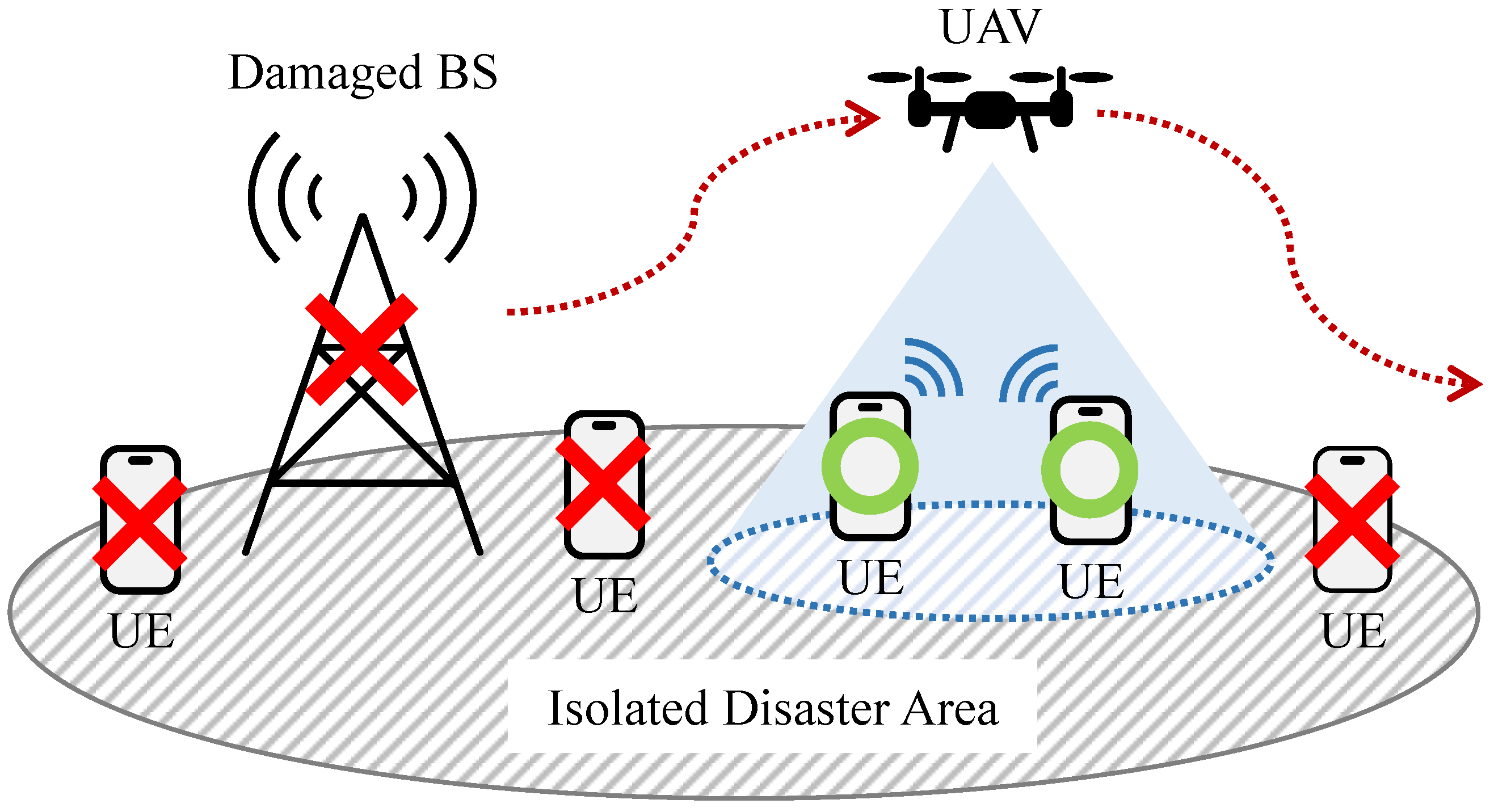



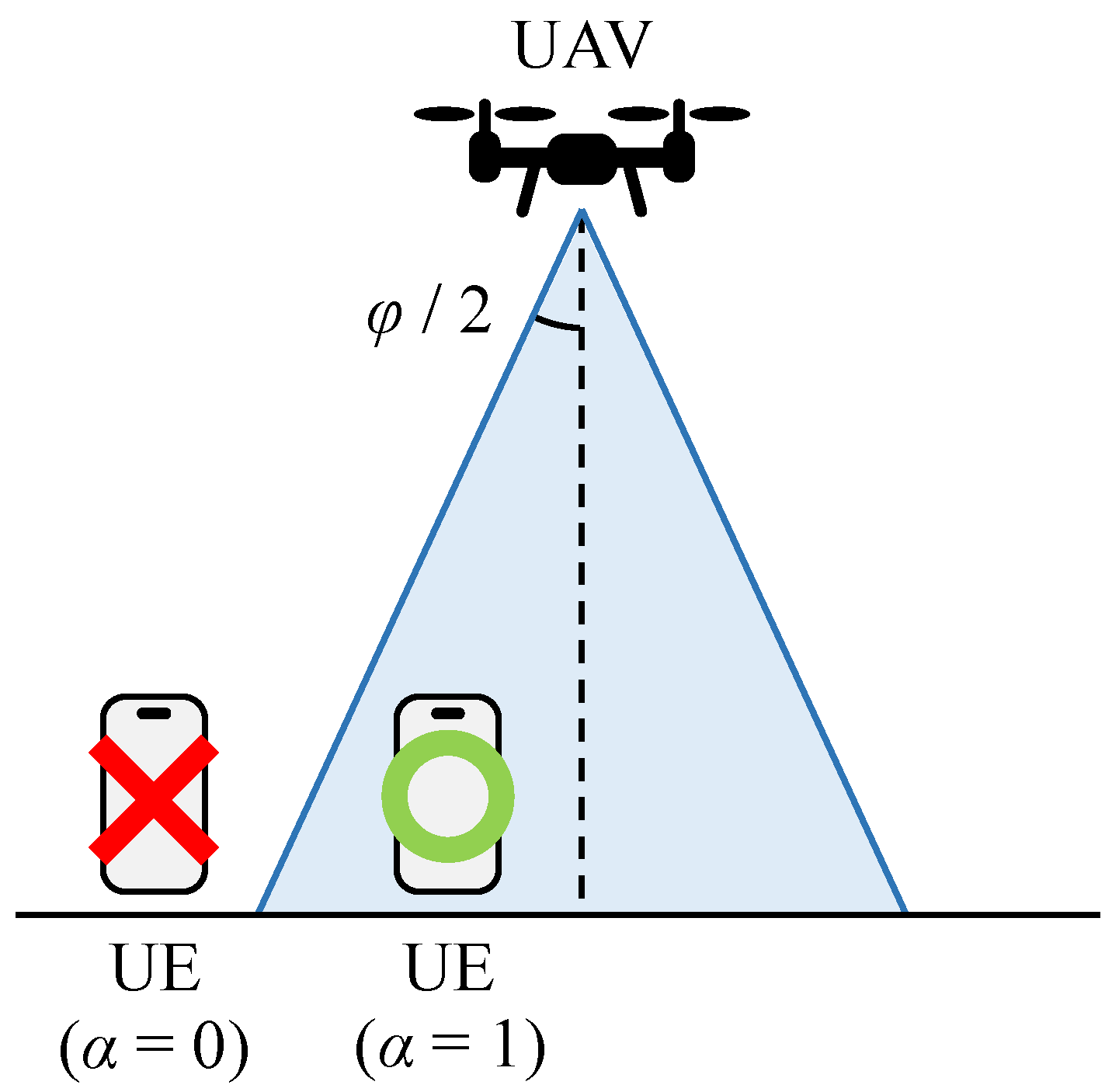
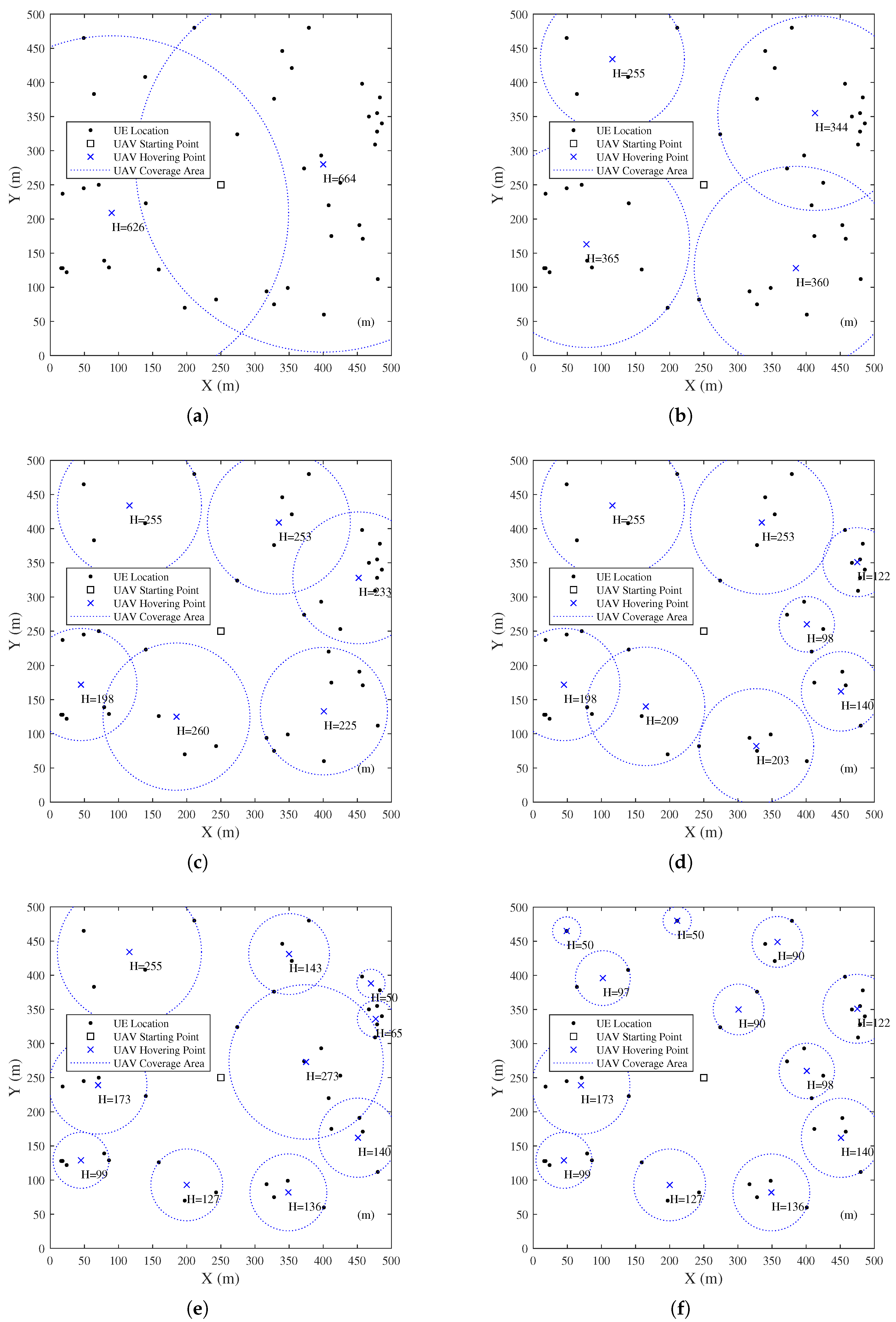




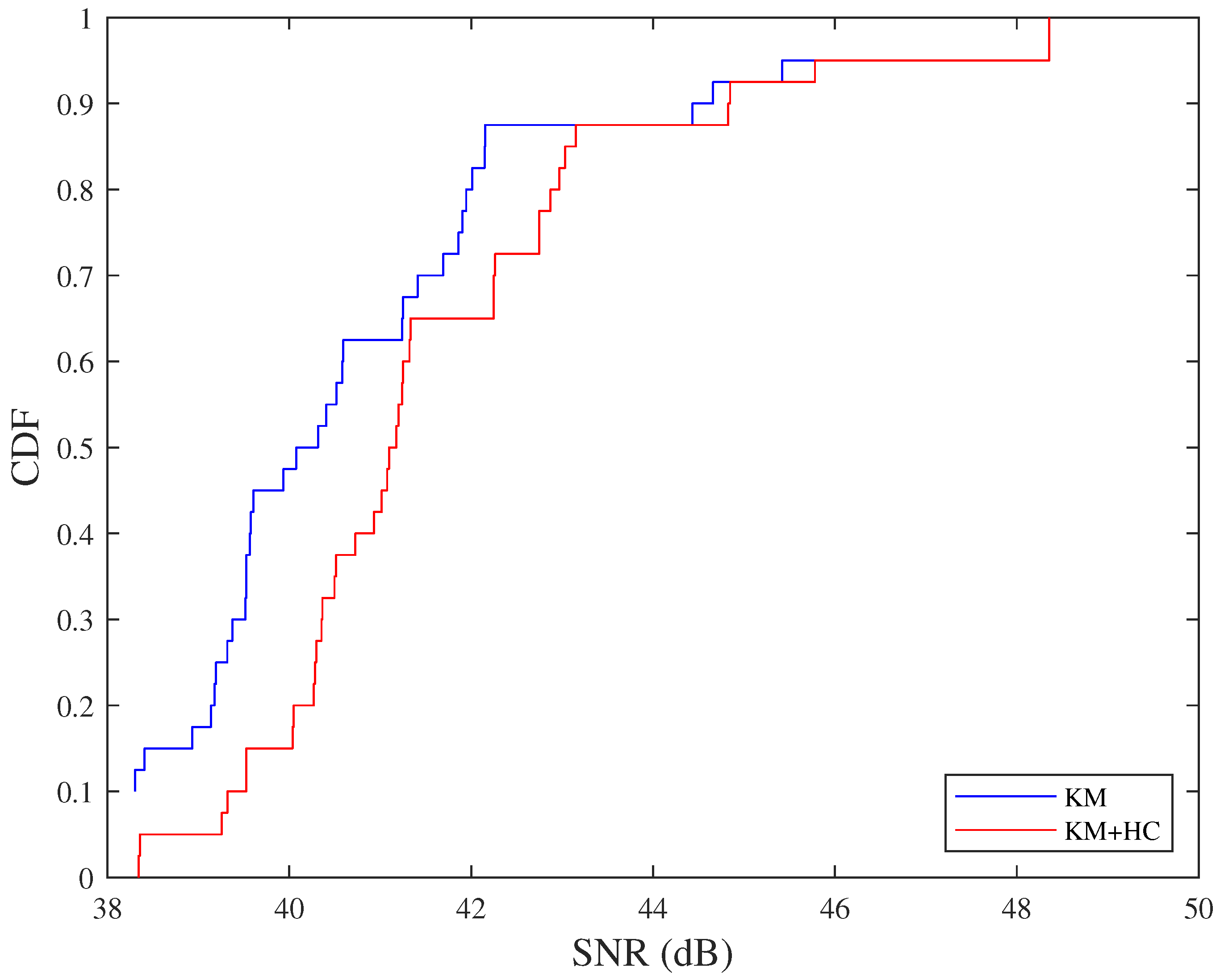

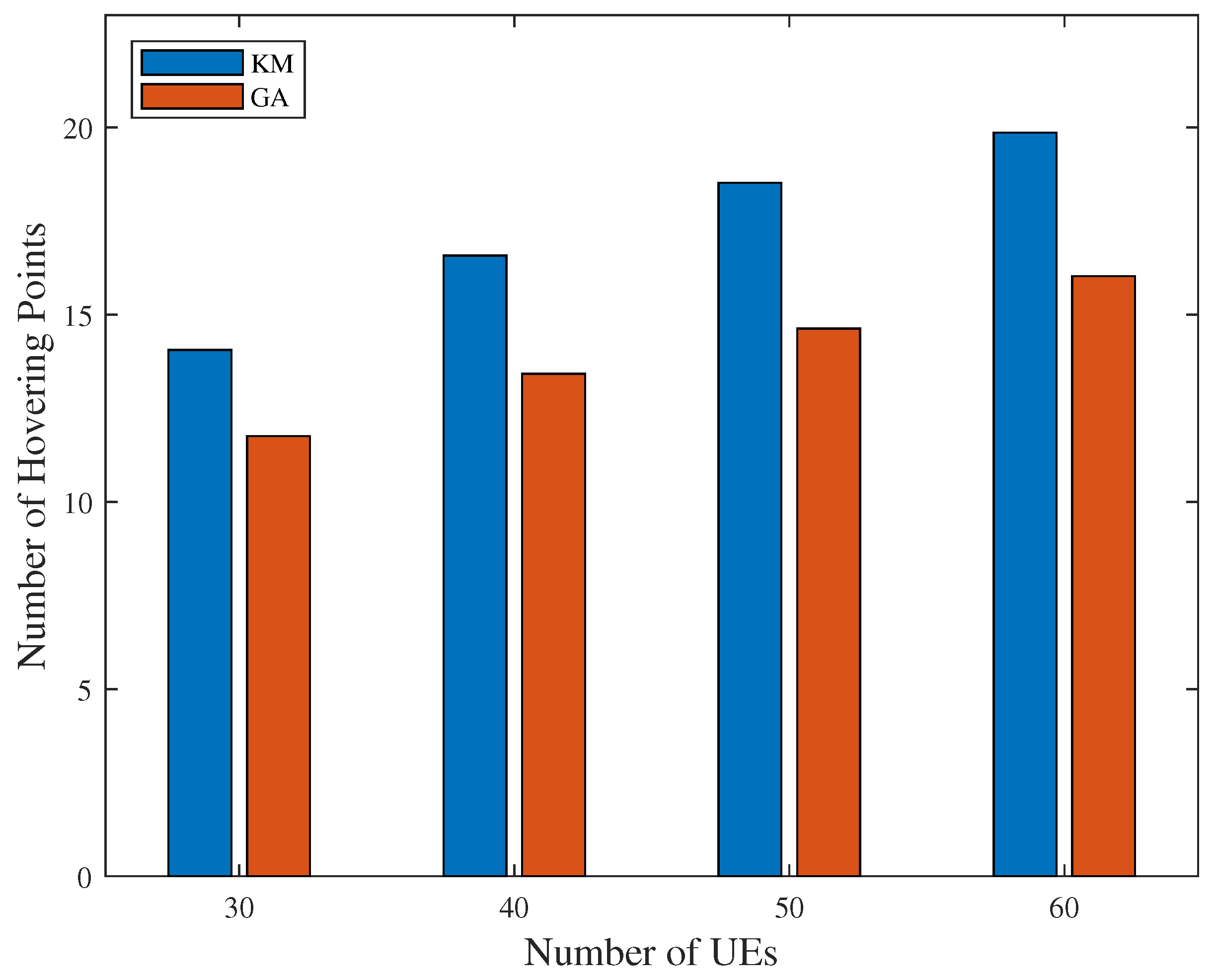

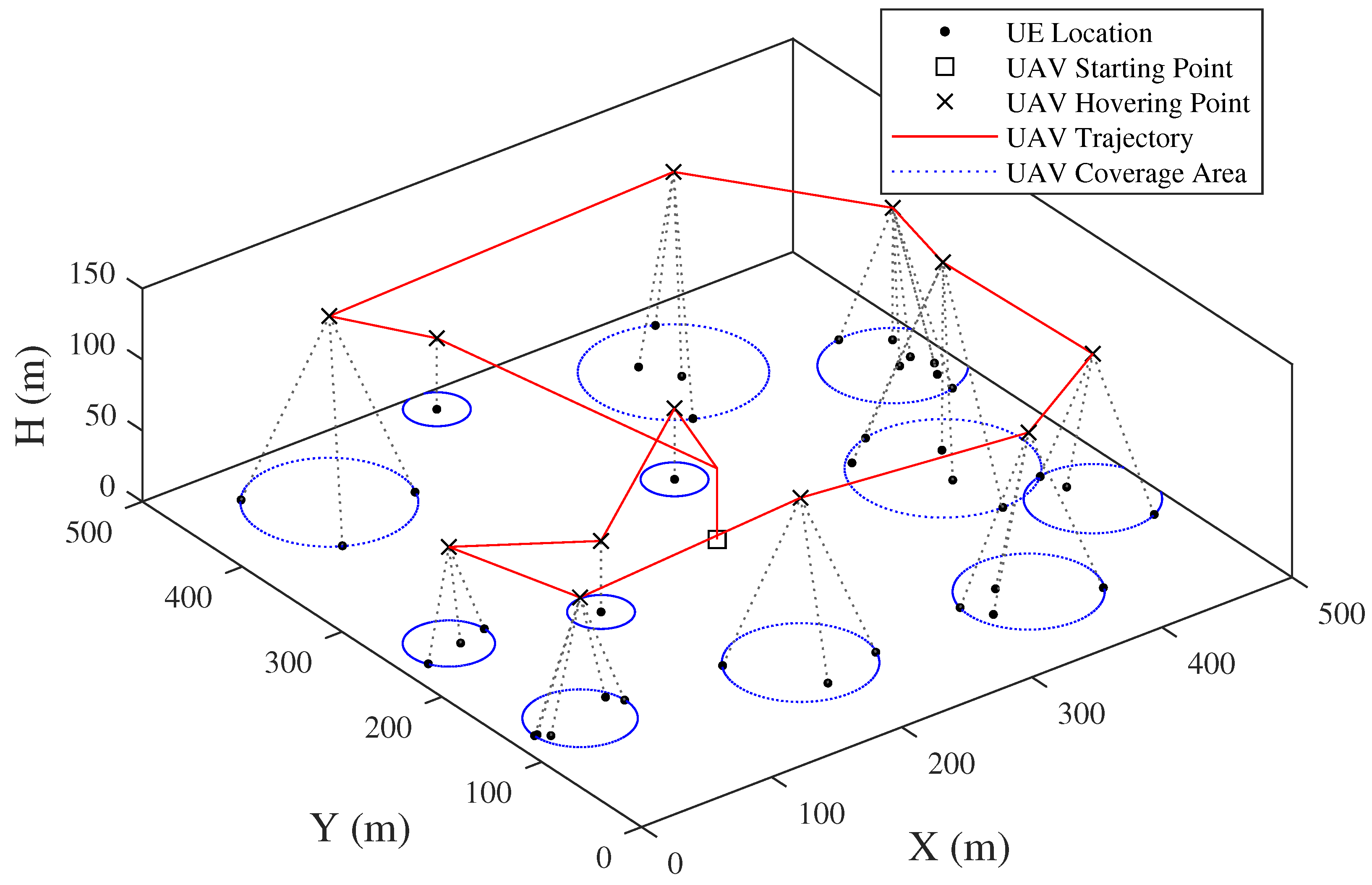
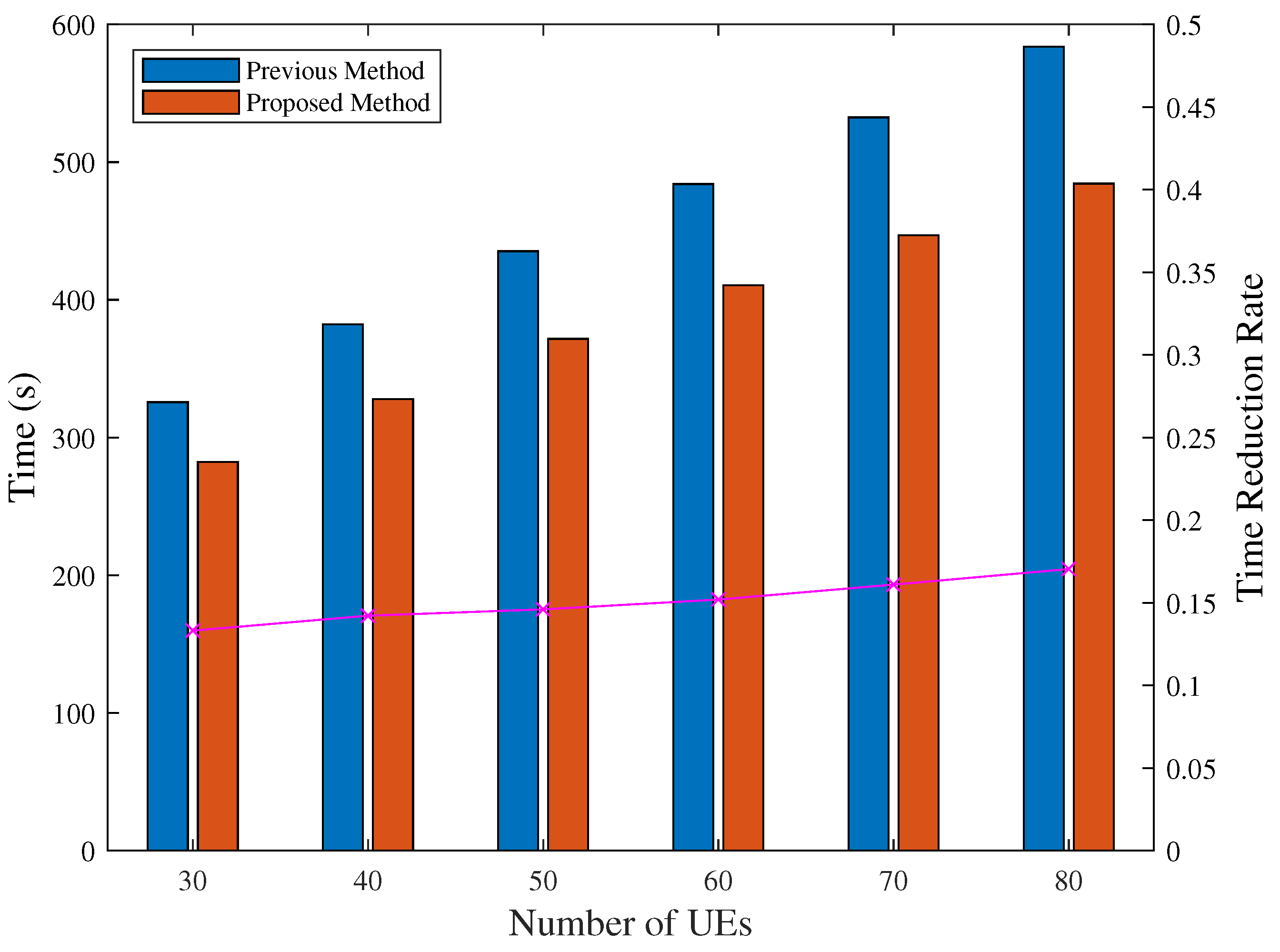
| Study | Application Focus | Key Technologies | Contributions | Limitations |
|---|---|---|---|---|
| [18] | Rural connectivity enhancement | Path planning and UAV relays | Focused on improving link quality in rural zones | Limited to rural; not scalable for high-mobility urban networks |
| [19] | Obstacle-aware deployment | Area barrier-aware deployment | Path optimization in obstacle-heavy environments | Focuses on fixed deployment scenarios |
| [20] | Disaster monitoring | Multi-UAV coordination | Disaster-focused UAV coordination and communication | Does not focus on data collection optimization |
| [21] | Surveillance via DRL | Deep Reinforcement Learning (DRL) | Multi-UAV collaboration using DRL | Specific to surveillance, not general data collection |
| [14] | Data collection | Multi-armed bandit (MAB) | Consideration of energy consumption of UAV and UE | 2D trajectory optimization |
| [22] | Data collection | Markov decision making process (CMDP) | Consideration of energy consumption of UE | No consideration of energy consumption of UAV |
| [23] | Data collection | Traveling salesman problem (TSP) | Completion time minimization | 2D trajectory optimization |
| [24] | Data collection | Segment-based trajectory optimization algorithm (STOA) | Joint optimization of trajectory and link scheduling | 2D trajectory optimization |
| [25] | Data collection | Single LAP covering a whole area | Coverage enhancement | Limited data rate |
| [26] | IoT networks | K-means clustering | Energy harvesting efficiency | No discussion on data transmission |
| [27] | Flying base station | Offline-based online adaptive (OBOA) design | Wind consideration | No discussion on completion time |
| [28] | Flying base station | 3D placement | Maximum coverage of UEs with different QoS requirements | No discussion on completion time |
| Parameter | Value |
|---|---|
| Frequency (MHZ) | 2412 |
| Bandwidth B (MHz) | 22 |
| Boltzmann Constant | |
| Temperature T (K) | 298 |
| Environment S-Curve Parameter a | 9.61 |
| Environment S-Curve Parameter b | 0.16 |
| LoS Additional Loss | 1 |
| NLoS Additional Loss | 20 |
| UAV Antenna Type | Directional |
| UAV Antenna Half Width (rad) | |
| UAV Forward Velocity (m/s) | 14 |
| UAV Ascent Velocity (m/s) | 5 |
| UAV Descent Velocity (m/s) | 4 |
| UE Antenna Type | Omnidirectional |
| UE Transmission Power (mW) | 200 |
| UE Maximum Data Size (MB) | 10 |
| Number of UEs | Total Time (s) | Flight Time (s) | Hovering Time (s) | |||
|---|---|---|---|---|---|---|
| Previous Method | Proposed Method | Previous Method | Proposed Method | Previous Method | Proposed Method | |
| 30 | 325.6855 | 282.3203 | 240.3592 | 195.8832 | 85.3263 | 86.4371 |
| 40 | 382.1829 | 327.8415 | 268.4145 | 210.7790 | 113.7684 | 117.0625 |
| 50 | 435.2349 | 371.6828 | 293.0245 | 224.9754 | 142.2105 | 146.7074 |
| 60 | 484.0537 | 410.4997 | 313.4011 | 233.1659 | 170.6526 | 177.3338 |
| 70 | 532.5094 | 446.7737 | 333.4147 | 239.3245 | 199.0947 | 207.4491 |
| 80 | 583.8943 | 484.3886 | 356.3576 | 246.9312 | 227.5368 | 237.4574 |
Disclaimer/Publisher’s Note: The statements, opinions and data contained in all publications are solely those of the individual author(s) and contributor(s) and not of MDPI and/or the editor(s). MDPI and/or the editor(s) disclaim responsibility for any injury to people or property resulting from any ideas, methods, instructions or products referred to in the content. |
© 2025 by the authors. Licensee MDPI, Basel, Switzerland. This article is an open access article distributed under the terms and conditions of the Creative Commons Attribution (CC BY) license (https://creativecommons.org/licenses/by/4.0/).
Share and Cite
Zhao, R.; Tran, G.K. Three-Dimensional Trajectory Optimization for UAV-Based Post-Disaster Data Collection. J. Sens. Actuator Netw. 2025, 14, 63. https://doi.org/10.3390/jsan14030063
Zhao R, Tran GK. Three-Dimensional Trajectory Optimization for UAV-Based Post-Disaster Data Collection. Journal of Sensor and Actuator Networks. 2025; 14(3):63. https://doi.org/10.3390/jsan14030063
Chicago/Turabian StyleZhao, Renkai, and Gia Khanh Tran. 2025. "Three-Dimensional Trajectory Optimization for UAV-Based Post-Disaster Data Collection" Journal of Sensor and Actuator Networks 14, no. 3: 63. https://doi.org/10.3390/jsan14030063
APA StyleZhao, R., & Tran, G. K. (2025). Three-Dimensional Trajectory Optimization for UAV-Based Post-Disaster Data Collection. Journal of Sensor and Actuator Networks, 14(3), 63. https://doi.org/10.3390/jsan14030063






